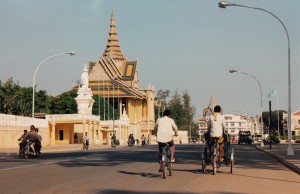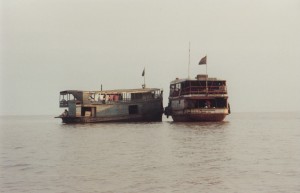[In January 2003 I accompanied an expedition that was conducting a survey of river dolphins on a stretch of the Mekong River in Cambodia. The expedition was led by Isabel Beasley, who was then a PhD student specializing on Orcaella brevirostris: also known as the ‘Irrawaddy Dolphin’ this species is found in many Asian river systems and deltas. The journal I kept during the expedition will appear on this site as a continuous series of posts. This is part 10 of the series.]
Clasico’s story: In June-July 2001 a group of dolphins was seen about 40 kms from Phnom Penh in the floodplains.

This was very unusual, because dolphins are rarely seen that far south. There are only anecdotal reports of dolphins around Phnom Penh in recent years and the last official sighting in the Tonle Sap was in the 1970s.

The group seen in 2001 was also unusual in that they were roaming about the flood-plain – in other words they were at large in the submerged rice paddies, in water that was only a few metres deep. These sightings were in an area called Preah An Chung. As the year progressed and the water levels dropped most of the dolphins managed to get back to the river. But two of them didn’t manage to get out and at the onset of the dry season they found themselves trapped. One was caught in a small tributary – a waterway that still had a useable connection to the river. But for some reason the dolphin failed to make use of it and remained trapped within the tributary. The second dolphin was caught in an irrigation channel – or rather a fish-pond that was connected to the river by an irrigation channel. This was the animal that would come to be known as Clasico.
The local people alerted the Fisheries Department to the presence of these animals and through them word reached Isabel. Over the next few months, that is Sept-Nov, Isabel visited the dolphin many times – 40 or 50 times. She would spend weeks at a stretch in Phnom Penh and every day she would drive out, on a hired moped, to see the dolphins. She’d visit both of them but she’d spend more time with Clasico because he was caught in a smaller pool and it was evident from the start that at a certain point he would have to be caught and released. The other dolphin had a larger area to inhabit and Isabel assumed that he’d be able to get out under his own steam some day. But with Clasico she had to take many precautionary measures from the start – she took soundings of his pool and built a fence to keep boats and children out of the deeper areas. Because the pool still had a connection with the river, the fish escaped and the dolphin’s food supply dwindled. So she started bringing Clasico fish to feed on. The fish were barely alive when she got them there and Clasico would eat the first couple but not the others – this despite the fact that he was losing a lot of weight and was becoming quite emaciated.

